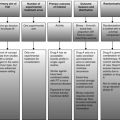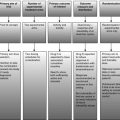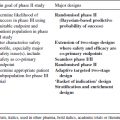12 Matthew Seymour and Sarah Brown Drug E is a monoclonal antibody therapy targeting a cell surface receptor, ‘Receptor X’, that is known to be involved in cell growth from some cancers. Retrospective studies have shown that Receptor X is strongly expressed in around 5% of colorectal cancers, and it is now hypothesised that drug E, given in combination with current standard chemotherapy, will improve efficacy for patients with X-positive advanced colorectal cancer (aCRC) after failure of first-line chemotherapy. Receptor X is not routinely measured in aCRC, so there are only limited historical data from previous trials on which to base the expected control outcomes in this specific group. Phase III clinical data are available for the efficacy of drug E in other solid tumours where Receptor X is more commonly expressed, and it is hoped that a similar treatment effect will occur in X-positive aCRC. Drug E has demonstrated an acceptable toxicity profile in studies in other disease areas. A phase II trial of drug E in combination with standard second-line chemotherapy, for Receptor-X-positive aCRC patients, is proposed to determine whether to proceed to a larger phase III trial. Mechanism of action: Drug E is a monoclonal antibody directed against Receptor X. It is believed to be primarily cytostatic as a single agent, but to act synergistically with standard cytotoxic chemotherapy. In the setting of second-line treatment for aCRC, classical cytotoxic chemotherapies are associated with low response rates due to high levels of tumour resistance. It is, therefore, unrealistic to expect the addition of drug E to chemotherapy to induce a high response rate. An assessment of disease control, that is, progression-free survival (PFS), offers a more realistic measure of the efficacy of this combination in this setting. Aim of treatment: The ultimate aim of second-line treatment of patients with advanced disease is to prolong overall survival. An early indicator of treatment activity is the ability to prolong PFS, as discussed above. Single or combination therapy: Drug E is given in combination with standard second-line chemotherapy; to be relevant, therefore, the activity of the combination therapy would need to be greater than that of chemotherapy alone. Biomarkers: Drug E targets the specific cell surface receptor, Receptor X, so the trial will be focused specifically on patients with X-positive tumours. On the basis of evidence in other disease areas, the drug is not expected to improve clinical outcomes in patients with X-negative tumours; these patients will, therefore, be excluded. There are no validated biomarkers associated with aCRC which may provide an alternative assessment of therapeutic activity. There is confirmed clinical evidence of efficacy of drug E in other solid tumours (breast and gastrointestinal cancer). Owing to the small population of patients available, the current phase II trial is designed to deliver proof of concept in this targeted population of patients and a go/no-go decision for a subsequent phase III trial. It is important to consider the most efficient trial designs due to the rarity of the target population, as well as the length of time required for a drug to move from phase II to phase III then into routine clinical practice. A pragmatic approach to designing trials in these settings is essential, to ensure reliable and robust trial design, whilst maintaining an efficient and achievable drug development pathway. There is only one experimental treatment under investigation, so a selection trial is not required. Drug E has shown an acceptable toxicity profile in multiple studies in other solid tumours. The current combination in aCRC is expected to have only minimal additional toxicity or functional deficit. While toxicity will form a secondary endpoint of the phase II trial, the primary outcome of interest is activity. In this heavily pre-treated population of patients, response rates to chemotherapy are historically low and the addition of drug E is not expected to induce a high response rate. The use of PFS as an indicator of activity may, therefore, be more appropriate and clinically relevant. PFS is strongly correlated with overall survival in patients with aCRC (Buyse et al. 2007), albeit predominantly in the setting of trials of chemotherapeutic agents. Chemotherapy plus drug E will be given for an initial period of 12 weeks, reflecting the initial treatment period of standard chemotherapy. After this point, patients who have not progressed will continue to receive drug E until progression. Assessments of disease status via CT scan will be carried out approximately 12-weekly until disease progression. Median PFS with standard chemotherapy is approximately 4.8 months in patients with advanced colorectal cancer following first-line therapy, but data specifically for patients with X-positive colorectal cancer are limited (see Section 12.4 for further details). This population of patients represents a rare subgroup of aCRC patients, so recruitment to the study will likely be slow. A binary outcome dichotomising PFS at a single time point (i.e. the proportion of patients free of disease progression at a specific time point) is worthy of consideration due to the long period of recruitment and the requirement otherwise for all patients to be followed up to disease progression. If inclusion of interim assessments during the trial is being considered, however, the requirement to wait for all patients to be followed up to the specific time point of interest before this can take place may be impractical. The use of all time-to-event data up to and including the specific time point may be considered a possibility in this setting. Conversely, PFS will be limited and the use of a time-to-event outcome (i.e. overall PFS) may be preferable since this incorporates all available information from the trial and will further facilitate design of the potential phase III trial that would have a time-to-event primary outcome measure.
Targeted therapy for advanced colorectal cancer
Stage 1 – Trial questions
Therapeutic considerations
Primary intention of trial
Number of experimental treatment arms
Primary outcome of interest
Stage 2 – Design components
Outcome measure and distribution
Randomisation
Stay updated, free articles. Join our Telegram channel

Full access? Get Clinical Tree






